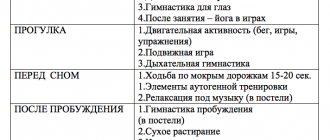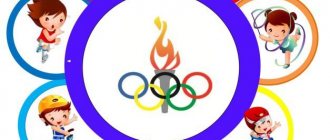Corrective exercises
In addition to basic physical education, in some preschool institutions children are taught yoga, self-massage, acrobatics, sports dancing, and rhythmic gymnastics.
I wonder what is the purpose of health-saving technologies in preschool educational institutions, during the application of which music is used? In fact, experts assign a special role to music in health improvement and treatment and preventive programs for children. Music lies to help develop cross-functional training. Music classes significantly enrich and enhance the health-improving focus of all forms of physical activity and help prepare children for school.
The goal of using health-saving technologies in preschool educational institutions is considered by many experts to be the implementation of comprehensive pre-school training, which is aimed at developing motor skills, honing the mechanisms of memory, speech, reading, thinking, artistic and visual activities, and musicality.
A lot of attention and time is paid to teaching the basics of a healthy lifestyle, as one of the important conditions for maintaining the health of preschoolers. The teaching staff is forced to carry out extensive work on the valeological education of children and talk with parents. For children, special techniques and techniques are selected that allow them to present information about the structure of the body in an accessible form, explain how important it is to eat right, sleep during the day, go for a walk, etc. Thus, children are taught a healthy lifestyle from an early age.
Mental and psychological development of preschool children
Another goal of health-saving technologies in preschool educational institutions according to the Federal State Educational Standard is the formation of accessible knowledge in preschoolers, taking into account age and individual characteristics of perception. Teachers pay a lot of attention to the system of teaching hygiene skills to children under seven years of age. In practice, the best results in mastering the rules of a healthy lifestyle are demonstrated by children 3-5 years old due to the most productive organization of sensorimotor activity. The best results can be achieved if you work with children in a playful way, using thematic, didactic, mobile, board-printed, role-playing and other types of games.
We must not forget about modern methods of strengthening mental health and creating conditions for a preschooler’s comfortable well-being. Today, a variety of gaming technologies are being improved that are used to maintain the health of kindergarteners.
Since the effectiveness of using health-saving technologies in preschool educational institutions depends on the contact and cooperation of teachers and parents, the forms of interaction between them become most important. Meeting formats such as:
- parent meetings, for which a specialist (psychologist) is invited to conduct tests and consultations;
- gaming workshops;
- open days;
- school of successful parents;
- experience exchange.
Such classes will help improve the pedagogical culture of parents and help them understand the true purpose of physical education in promoting the health of a preschooler.
Introduction of technologies to support children's health
Kindergarten belongs to the state system of compulsory universal education. Teaching preschoolers the basics of life, health and hygiene rules is a priority activity of the preschool educational institution. What is the purpose of health-saving technologies? The main task that teachers face during the educational process is to set the child up to lead a healthy lifestyle.
In fact, the concept of health-saving pedagogical technologies in preschool educational institutions and the concept of developing a healthy lifestyle are identical. They are paramount in the work of participants in the educational process of each preschool institution.
The basic rules of health are as follows:
- maintain a daily routine;
- show physical activity;
- pay attention to balanced nutrition;
- maintain a normal psychological atmosphere and positive mood.
When working on the creation of health-saving technologies in the educational process of preschool educational institutions, it is necessary to take into account adapted forms of work and the characteristics of the age group. Teachers in kindergarten use various methods to maintain the health of children and their comprehensive development.
Classification of measures to protect and promote the health of preschool children
Today, several types of health-saving technologies are used in preschool educational institutions. These include:
- medical, preventive and physical education measures;
- basics of social and psychological well-being of a preschool child;
- valeological education of parents;
- correctional classes.
You might be interested: What is a lever in physics? The principle of operation of the lever. Types of levers
Each of the above types has its own characteristics. For example, monitoring the health of preschool children and organizing control over compliance with sanitary rules and regulations are considered fundamental elements of medical and preventive technologies. The goals of health-saving technologies in preschool educational institutions include the development of recommendations for optimizing the nutrition of children of primary and preschool age, physical education, hardening, breathing exercises, massage and other preventive measures (to prevent flat feet, the formation of correct posture).
Ensuring the social and psychological well-being of a preschooler directly depends on pedagogical support. A teacher in a preschool educational institution must instill in the child and parents a culture of health, have valeological knowledge, and be able to give an objective assessment of their strengths and weaknesses related to professional activities. Technologies for valeological education of parents include the design of thematic folders, holding parent meetings, individual conversations, practical demonstrations and providing non-traditional forms of interaction with the legal representatives of children.
The general well-being and mood of the child depends on whether parents pay attention to the health of their child and whether they organize the daily routine correctly. But then what is the purpose of health-saving technologies in preschool educational institutions? In an educational institution, the skills and abilities acquired by the child at home are consolidated, and new information received in kindergarten will never become unnecessary or burdensome for the preschooler.
Physical activity
One of the most popular and convenient methods for working with children is step aerobics. This type of physical education and health activity belongs to the group of health-saving technologies in preschool educational institutions. Each lesson should last no more than 10-30 minutes. Also, step aerobics can be introduced into the learning process in the form of separate blocks as elements of each physical education lesson.
In a preschool institution, this type of lesson, aimed at maintaining motor activity, with a maximum duration (25-30 minutes) is used only for children of older preschool groups. Step aerobics is also of a health-improving and training nature for children in the form of morning exercises, which gives not so much a health-improving effect as an emotional one. The duration of classes for children of younger groups is no more than 10-15 minutes. In addition, elements of step aerobics can be used in the form of demonstration performances at children's parties and as entertainment.
This type of physical education promotes the development of dexterity and speed, teaches children to navigate in space, and strengthens the vestibular apparatus. Step aerobics classes bring joy and delight to children, give them freedom of movement, improve their well-being, giving them a feeling of joy and maintaining a positive mood.
You may be interested in:Education in Singapore: system features and reviews
Another special technique used in working with children is the so-called “alphabet of body movements.” According to the Federal State Educational Standard, the goal of health-saving technology in preschool educational institutions is to increase the physical activity of children during their stay in the institution. The essence of this method is as follows: it is necessary to perform certain motor actions on any of the letters of the alphabet. For older children this is a very exciting and funny game. The “Alphabet of Body Movements” consists of three dozen poses, each of which corresponds to a specific letter of the alphabet. The children’s task is to visually or auditorily perceive the name of the letter and, having made the correct movement, depict this letter.
Primary tasks
You might be interested: Do you know how many megapixels are in the human eye?
The average child spends most of his time in kindergarten. The main purpose of preschool educational institutions is not only to look after children in the absence of their parents, but also to prepare children for independent life, teaching them basic knowledge, skills and abilities. In this context, an important role is played by the attitude of educators to the health status of their pupils and the correct use of health-saving technologies in the work of preschool educational institutions.
This term is commonly understood as a system of measures to protect and promote the health of children. It recently appeared in the professional vocabulary of teachers. The goals of health-saving technologies in preschool educational institutions have not undergone even the slightest changes over the years of their use. This is a whole system of measures to protect and promote the health of children, which faces the following tasks:
- provide the child with all the conditions for maintaining health;
- provide basic knowledge about the benefits of a healthy lifestyle;
- teach basic skills and teach them to apply them in everyday life.






